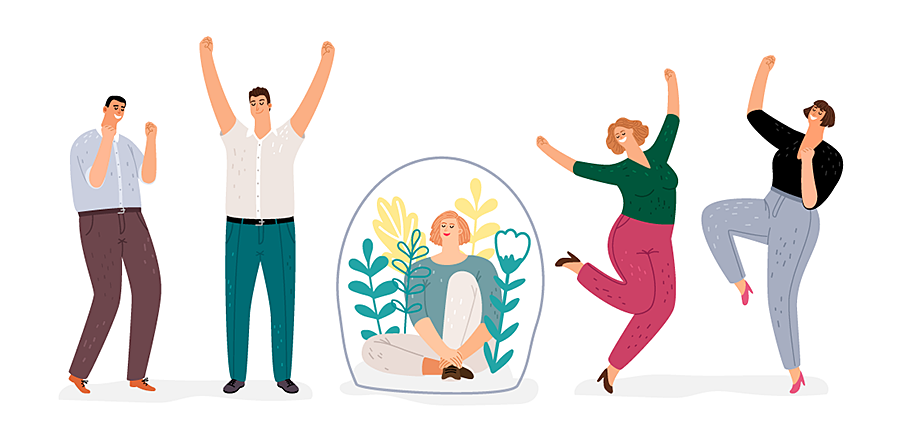Help employees stay socially connected in the workplace
Before COVID, we were already starting to experience a global loneliness epidemic. Over the last few months, COVID-19 has shone an even brighter light on this important issue and the impact that isolation and loneliness can have on an employee’s overall sense of well-being.
Loneliness can lead to mental illness such as depression and addictive behaviours[1]. And if left to fester, it can also erode physical health. It is linked to early mortality and has the same effect as smoking 15 cigarettes a day in terms of health care outcomes and costs.[2]
Research published by the New Economics Foundation in the UK found that lonelier workers perform poorly more often and report less job satisfaction, and this costs employers £2.5 billion ($3.5 billion US) in the United Kingdom alone.[3] Another study of 477 workers across 99 workgroups found[4] that lonelier employees are:
- Less committed to their organization
- At greater risk of being perceived as poor performers
- Less approachable
- Reluctant to offer help
Recently, WSPS, in partnership with Howatt HR, produced an interim research report which looks at the relationship between perceived isolation, loneliness and resilience and their impact on the employee experience and productivity costs in the workplace.
Like the studies referenced above, the preliminary results of our research show a strong correlation between loneliness and isolation and higher productivity costs.
Helping employees feel a greater sense of connection can have a direct impact on engagement, retention productivity and performance. Employees who feel more connected to a safe social network typically put forth more discretionary effort and tend to take less sick time.
How can you help employees stay socially connected?
- Be Aware - Realize that any employee experiencing isolation and loneliness in the workplace perceives an absence of meaningful social connections.[5] And, because they are subjective, loneliness and isolation are not always easily detected. An employee may seem okay when they are actually experiencing intense feelings of isolation and loneliness that, if not detected and resolved, over time, can negatively affect the employee’s experience in the workplace, health, and productivity.
- Understand the difference between isolation and loneliness - There is rarely only one factor contributing to feelings of isolation. The longer we perceive feelings of isolation the greater the risk of loneliness. To gain a better understanding of this, you can complete the Perceived Isolation-Loneliness Effect survey. A personalized report provides further insight into difference between isolation and loneliness and also offers a few coaching tips on what can be done to close gaps.
- Break down barriers - Leaders who actively and openly talk about the importance of social connections can reduce the risk of employees suffering in silence or experiencing stigma. The more leaders believe and care that social connections in the workplace matter, the greater the likelihood that employees will come forward when they’re struggling.[6] Like any mental health issue, a lack of awareness is a barrier to asking for help.
- Social connections strategy - A growing number of employees are working remotely because of COVID-19, which may become the new norm for many. To protect employees’ mental health and maximize productivity, leaders should consider their strategy to help employees maintain and develop meaningful social connections in the workplace. The strategy may include:
- Check in -The goal is to build a healthy social connection with the employee so they don’t feel alone in the workplace and have at least one safe relationship they can count on.
- Employee support - Educate employees about psychological support services, including peer, buddy, and training programs that can help those who are struggling get the support they need. Include programming on isolation and loneliness and how they can be curbed by developing meaningful social connections in the workplace.
- Leverage technology - Use technology that promotes social connections. HuGr Authentic Connections is a new technology designed to help employees struggling with social connection to learn how to build healthy, authentic connections and move past isolation or loneliness.
Download: Exploring the relationships between perceived isolation, loneliness and resiliency. Early insight, July 2020. (1.14 MB PDF)
PILOT OPPORTUNITY: Hugr Authentic Connections, WSPS and Howatt HR will be launching a study to pilot this new employee software within the WSPS client base in November. If you’re interested, please contact Krista Schmid at krista.schmid@wsps.ca as space is limited.
References
1 https://www.ncbi.nlm.nih.gov/pmc/articles/PMC4225959/
2 https://pubmed.ncbi.nlm.nih.gov/25910392/
3 https://neweconomics.org/2017/02/cost-loneliness-uk-employers/
4https://faculty.wharton.upenn.edu/wp-content/uploads/2012/05/Work_Loneliness_Performance_Study.pdf
5http://www.ceohsnetwork.ca/blog/psychological-safety/psychological-safety-blog/
6https://www.conferenceboard.ca/focus-areas/health/how-has-covid-19-impacted-canadians-mental-health
Get to know the author – Dr. Bill Howatt

 Dr. Bill Howatt
Dr. Bill Howatt



